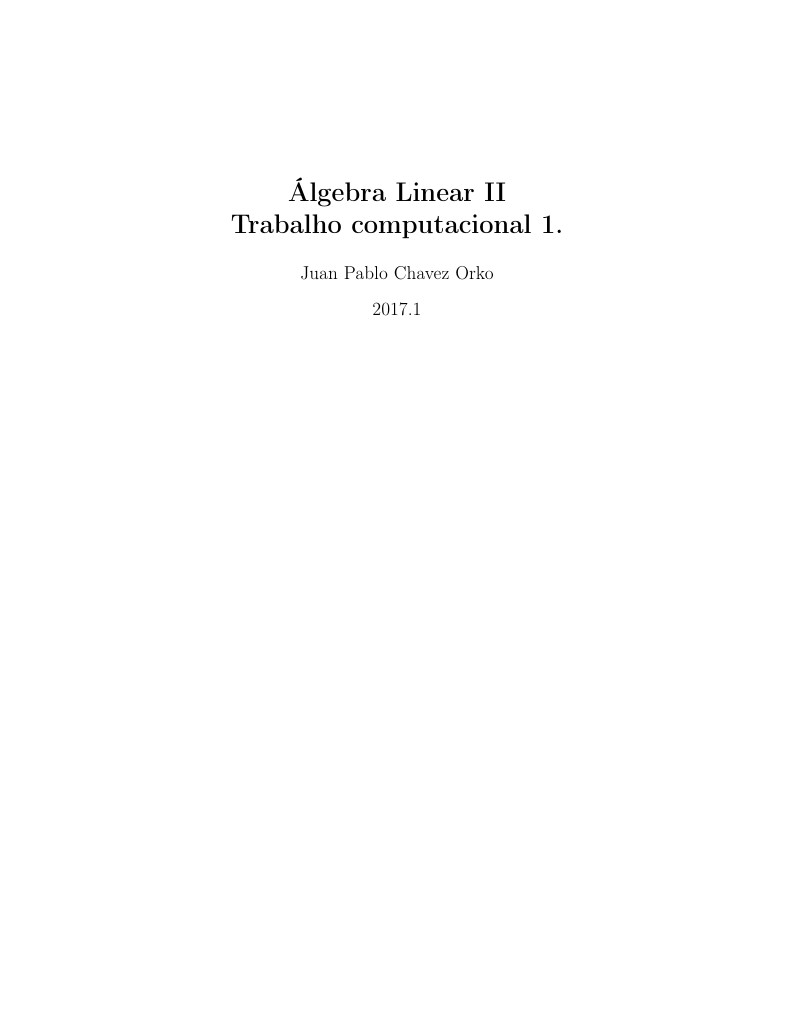
Álgebra Linear II
Author:
eu
Last Updated:
9 anni fa
License:
Creative Commons CC BY 4.0
Abstract:
Álgebra Linear II

\begin
Discover why over 20 million people worldwide trust Overleaf with their work.
Álgebra Linear II

\begin
Discover why over 20 million people worldwide trust Overleaf with their work.
\documentclass[12pt]{article}
\usepackage[portuguese]{babel}
\usepackage[utf8x]{inputenc}
\usepackage[T1]{fontenc}
\usepackage{amsmath,amssymb,amsthm}
\usepackage{graphicx}
\usepackage{geometry}
\usepackage{tikz}
\pagestyle{empty}
\title{\textbf{Álgebra Linear II}\\ \textbf{Trabalho computacional 1.}}
\author{Juan Pablo Chavez Orko}
\date{2017.1}
\begin{document}
\maketitle
\thispagestyle{empty}
\newpage
\textbf{1)}Para resolver esta questão obtemos a matriz de links H como:
$$H=\begin{pmatrix}
0 & 0 & 0 & 0 & 0 & 0 & 1/3 & 0 \\
1/2 & 0 & 1/2 & 1/2 & 0 & 0 & 0 & 0 \\
1/2 & 0 & 0 & 0 & 0 & 0 & 0 & 0 \\
0 & 1 & 0 & 0 & 0 & 1/2 & 0 & 0\\
0 & 0 & 1/2 & 1/2 & 0 & 0 & 1/3 & 0\\
0 & 0 & 0 & 0 & 1/3 & 0 & 0 & 1/2\\
0 & 0 & 0 & 0 & 1/3 & 0 & 0 & 1/2\\
0 & 0 & 0 & 0 & 1/3 & 1/2 & 1/3 & 0
\end{pmatrix}$$
usamos a função eig para obtermos o vetor de importância
$$V^{T}=\begin{pmatrix}
-0.1161 & -0.3483 & -0.0580 & -0.5224 & -0.4063 & -0.3483 & -0.3483 & -0.4257
\end{pmatrix}$$
\textbf{2)}Vamos supor , por absurdo, que $\lambda = 1$ não e autovalor de uma matriz de links , ou seja, $det(H-1I) \neq 0.$ Seja $H=\begin{bmatrix}
h_{ij}
\end{bmatrix}_{n \text{x} n}$, note que cada coluna da matriz de links somam 1 e que a diagonal principal e composta por zeros.
$$\sum_{j=1}^{n}h_{ij}=1 \ \\\ \ H=\begin{pmatrix}
0 & * & * & \cdots & & *\\
* & 0 & * & \cdots & & *\\
\cdot & & \cdot & & & \cdot\\
\cdot & & &\cdot & & \cdot\\
\cdot & & & & \cdot & \cdot\\
* & \cdot & \cdot & \cdot & & 0
\end{pmatrix}$$
quando você faz a soma de $H - 1I$ vemos que a soma de cada coluna e zero, logo podemos escrever uma coluna como combinação linear das outras, com isso vemos que $H - I$ não e inversivel. Portanto $det(H-I)=0$ (absurdo), logo $\lambda=1$ e autovalor de H.
\\ \\\
\textbf{3)}Usando os algoritmos dos métodos da potência, potência inverso e potência inverso deslocado na matriz
$$A=\begin{pmatrix}
226 & -171 & 90 & -13 & 66\\
-171 & 162 & -15 & -13 & -57\\
90 & -15 & 284 & 32 & 8\\
-13& -13 &32 &55 &-16\\
66 & -57 & 8 & -16 & 128
\end{pmatrix}$$
obtemos os seguintes autovetores e $k$ iterações respectivamente
$$v_{1}=\begin{pmatrix}
1.0000\\ -0.7406\\ 0.6925\\ 0.0339\\ 0.3678
\end{pmatrix} k=33, \\\
v_{2}=\begin{pmatrix}
0.9025\\ 1.0000\\ -0.3074\\ 0.6444\\ 0.0794
\end{pmatrix} k=4,\\\
v_{3}=\begin{pmatrix}
-0.2048\\ 0.3331\\ 0.1350\\ -0.2889\\ 1.0000
\end{pmatrix} k=4$$
onde $v_{1}$ e associado ao maior autovalor, $v_{2}$ ao menor autovalor e $v_{3}$ ao autovalor mais proximo a $\alpha = 100$.
\textbf{4)}Para refazer a o exercício 1 vamos usar o método da potência, pois os outros metodo a necessidade de usar o inverso da matriz, e a matriz de links $H$ não e invertivel.
Vamos obter os seguintes resultados
$$V_{1}^{T}=\begin{pmatrix}
0.2222 & 0.6667 & 0.1111 & 1.0000 & 0.7778 & 0.6667 & 0.6667 & 0.8148
\end{pmatrix}$$
onde $V_{1}^{T}$ e autovetor associado a $\lambda = 1$, observe que $V_{1}^{T}$ é multiplo de $V^{T}$.
\end{document}